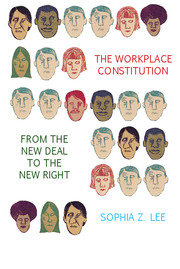Book contents
- Frontmatter
- Contents
- Acknowledgments
- Introduction
- Part I Crafting the Workplace Constitution in the New Deal 1930s and 1940s
- Part II Advancing the Workplace Constitution in the Cold War 1950s
- Part III Administering the Liberal Workplace Constitution in the Long 1960s
- Part IV The Workplace Constitution in the New Right 1970s and 1980s
- 10 Conservatives Reject the Liberal Workplace Constitution
- 11 Liberals Rethink the Workplace Constitution
- 12 Conservatives Unite the Workplace Constitutions
- 13 The Conservative Workplace Constitution Divides the New Right Coalition
- Epilogue
- Appendix: Figures
- Notes
- Selected Bibliography of Primary Sources
- Index
13 - The Conservative Workplace Constitution Divides the New Right Coalition
Published online by Cambridge University Press: 05 October 2014
- Frontmatter
- Contents
- Acknowledgments
- Introduction
- Part I Crafting the Workplace Constitution in the New Deal 1930s and 1940s
- Part II Advancing the Workplace Constitution in the Cold War 1950s
- Part III Administering the Liberal Workplace Constitution in the Long 1960s
- Part IV The Workplace Constitution in the New Right 1970s and 1980s
- 10 Conservatives Reject the Liberal Workplace Constitution
- 11 Liberals Rethink the Workplace Constitution
- 12 Conservatives Unite the Workplace Constitutions
- 13 The Conservative Workplace Constitution Divides the New Right Coalition
- Epilogue
- Appendix: Figures
- Notes
- Selected Bibliography of Primary Sources
- Index
Summary
“The Administration’s ... commitment to strict construction”
Howard Baker“No person should be forced to pay servitude to any organization whose ideology is contrary to their beliefs just in order to feed their family,” Harry Beck insisted. Square jawed and stocky, Beck grew up in the sleepy Chesapeake Bay town of La Plata, Maryland, where he took a working-class path through the tumultuous 1960s. After graduating from high school, Beck went to work at the local telephone company and happily joined the Communications Workers of America (CWA). In 1964, he returned to his job after a stint in the Air Force. This time, Beck was less happy with his union. He fought to wrest representation of outposts like his from large urban-based locals that he believed shorted small-town members on pay and protected a “radical element of the union hierarchy.” As Beck told it, after being excluded from secret union meetings, rebuffed by the National Labor Relations Board, and losing his coinstigators to mysterious deaths, his rebellion dissipated in 1966. In prevailing accounts, during the 1960s and 1970s, blue-collar workers took their political turns left or right without straying from the union. Beck instead quit the CWA, joined the National Right to Work Committee, and spent the next two decades fighting his former union from the outside.
In the 1970s, Beck and the National Right to Work Legal Defense Foundation extended the right-to-work movement’s constitutional challenge against agency shops to the vast majority of workplaces governed by the National Labor Relations Act. Forty years earlier, Cecil B. DeMille had pioneered the right-to-work movement so as to “change the minds of the city Councils, the legislatures, the governors, and the Congress” and ultimately “change the mind of the Supreme Court.” With conservatives’ clout rising during the 1970s and the partial victory of Abood already achieved, the movement he spawned seemed poised to claim that prize. Unless, that was, the ties between right-to-work advocates’ workplace Constitution and its liberal twin proved a liability rather than an asset, once conservatives came to power.
- Type
- Chapter
- Information
- The Workplace Constitution from the New Deal to the New Right , pp. 238 - 256Publisher: Cambridge University PressPrint publication year: 2014



